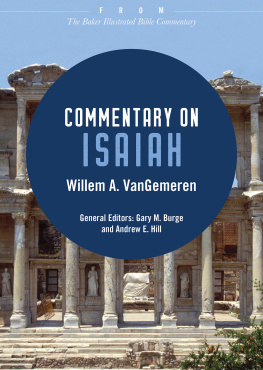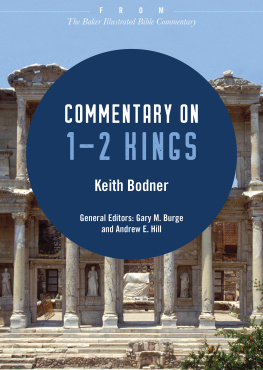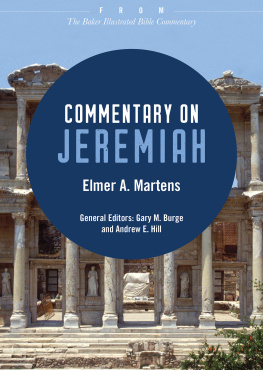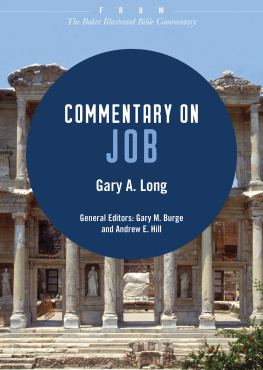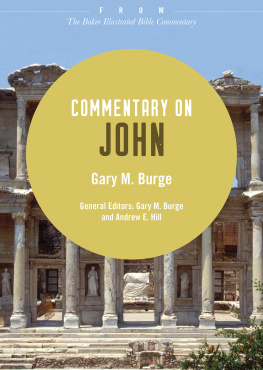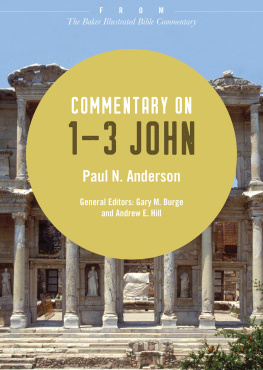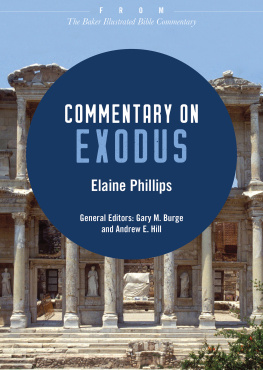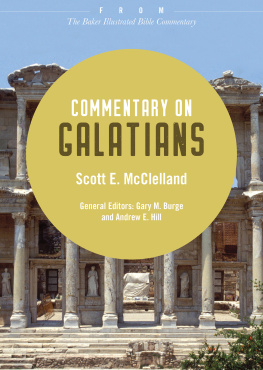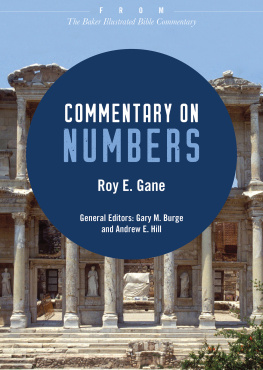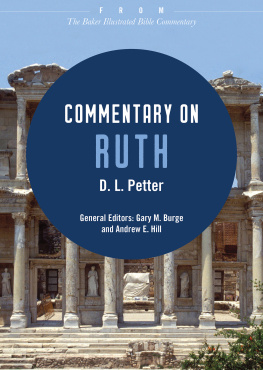Copyright Page
2012 by Baker Publishing Group
Published by Baker Books
a division of Baker Publishing Group
P.O. Box 6287, Grand Rapids, MI 49516-6287
www.bakerbooks.com
Ebook short created 2019
Previously published in The Baker Illustrated Bible Commentary edited by Gary M. Burge and Andrew E. Hill in 2012
All rights reserved. No part of this publication may be reproduced, stored in a retrieval system, or transmitted in any form or by any meansfor example, electronic, photocopy, recordingwithout the prior written permission of the publisher. The only exception is brief quotations in printed reviews.
Library of Congress Cataloging-in-Publication Data is on file at the Library of Congress, Washington, DC.
ISBN 978-1-4934-2457-3
Unless otherwise indicated, Scripture quotations are from the Holy Bible, New International Version. NIV. Copyright 1973, 1978, 1984, 2011 by Biblica, Inc. Used by permission of Zondervan. All rights reserved worldwide. www.zondervan.com. The NIV and New International Version are trademarks registered in the United States Patent and Trademark Office by Biblica, Inc.
Scripture quotations labeled ESV from The Holy Bible, English Standard Version (ESV), copyright 2001 by Crossway, a publishing ministry of Good News Publishers. Used by permission. All rights reserved. ESV Text Edition: 2007
Scripture quotations labeled NASB are from the New American Standard Bible, copyright 1960, 1962, 1963, 1968, 1971, 1972, 1973, 1975, 1977, 1995 by The Lockman Foundation. Used by permission. www.lockman.org
Scripture quotations labeled NIV 1984 are from the HOLY BIBLE, NEW INTERNATIONAL VERSION. NIV. Copyright 1973, 1978, 1984 by International Bible Society. Used by permission of Zondervan. All rights reserved.
Scripture quotations labeled NJPS are from the New Jewish Publication Society Version 1985 by The Jewish Publication Society. All rights reserved.
Scripture quotations labeled NKJV are from the New King James Version. Copyright 1982 by Thomas Nelson, Inc. Used by permission. All rights reserved.
Scripture quotations labeled NLT are from the Holy Bible , New Living Translation, copyright 1996, 2004, 2007 by Tyndale House. Used by permission of Tyndale House Publishers, Inc., Carol Stream, Illinois 60188. All rights reserved.
Scripture quotations labeled NRSV are from the New Revised Standard Version of the Bible, copyright 1989, by the Division of Christian Education of the National Council of the Churches of Christ in the United States of America. Used by permission. All rights reserved.
Scripture quotations labeled RSV are from the Revised Standard Version of the Bible, copyright 1952 [2nd edition, 1971] by the Division of Christian Education of the National Council of the Churches of Christ in the United States of America. Used by permission. All rights reserved.
Unless otherwise indicated, photos, illustrations, and maps are copyright Baker Photo Archive.
Contents
Abbreviations
| ANET | Ancient Near Eastern Texts Relating to the Old Testament . Edited by J. B. Pritchard. 3rd ed. Princeton, 1969 |
| BDAG | Bauer, W., F. W. Danker, W. F. Arndt, and F. W. Gingrich. Greek-English Lexicon of the New Testament and Other Early Christian Literature. 3rd ed. Chicago, 1999 |
| ca. | circa (about, approximately) |
| cf. | compare |
| chap(s). | chapter(s) |
| COS | The Context of Scripture . Edited by W. W. Hallo. 3 vols. Leiden, 1997 |
| e.g. | for example |
| ESV | English Standard Version |
| HALOT | Koehler, L., W. Baumgartner, and J. J. Stamm. The Hebrew and Aramaic Lexicon of the Old Testament. Translated and edited under the supervision of M. E. J. Richardson. 5 vols. Leiden, 19942000 |
| HCSB | Holman Christian Standard Bible |
| i.e. | that is |
| KJV | King James Version |
| NASB | New American Standard Bible |
| NEB | New English Bible |
| NET | New English Translation |
| NIV | New International Version (2011 edition) |
| NIV 1984 | New International Version (1984 edition) |
| NJB | New Jerusalem Bible |
| NJPS | The Tanakh: The Holy Scriptures: The New JPS Translation according to the Traditional Hebrew Text |
| NKJV | New King James Version |
| NLT | New Living Translation |
| NRSV | New Revised Standard Version |
| RSV | Revised Standard Version |
| TDOT | Theological Dictionary of the Old Testament . Edited by G. J. Botterweck and H. Ringgren. Translated by J. T. Willis, G. W. Bromiley, and D. E. Green. 8 vols. Grand Rapids, 1974 |
| TNIV | Todays New International Version |
Isaiah
Willem A. VanGemeren
Introduction
Isaiah the Prophet
Little is known about the prophet Isaiah other than that he loved Jerusalem, freely associated with Judahs kings, was married, and had two children. The name Isaiah means Yahweh is salvation. His name and the names of his sonsShear-Jashub (a remnant will return; see NIV note for 7:3) and Maher-Shalal-Hash-Baz (quickly to the plunder, swift to the spoil; see NIV note for 8:1)were symbolic to the nation (8:18). These three names capture the essence of the book: (1) Yahweh is the source of salvation; (2) Yahweh will spare a remnant for himself; and (3) Yahwehs judgment is certain to come.
The prophets relationship to the royal house of David has been a subject of speculation. The prophet moved easily into and out of the palace and had access to the king. He was respected by Ahaz and Hezekiah. Though this relationship does not prove that Isaiah was of royal lineage, it is clear that he held a respected position in the court. The tradition of Isaiahs royal lineage cannot, however, be demonstrated. Isaiah was, nevertheless, very familiar with court protocol and life in Jerusalem. He was respected in the court of Jerusalem even when he criticized the ruling classes.
Isaiahs father, Amoz, is not to be identified with the prophet Amos, who ministered a generation earlier in the northern kingdom. The spelling of these two names is different both in Hebrew and in English. Isaiah was a highly educated man who lived mainly in Jerusalem. He ministered to Gods people roughly from 742 to 700 BC in an era of great political tumult.
What little is known about Isaiahs death is derived from extrabiblical sources. There are several traditions that, when taken together, strongly suggest Isaiah may have suffered martyrdom under Manasseh, who succeeded Hezekiah.
Isaiah was a son of Jerusalem. The book is full of Isaiahs love and concern for the city. He believed the city was representative of the people as a whole.
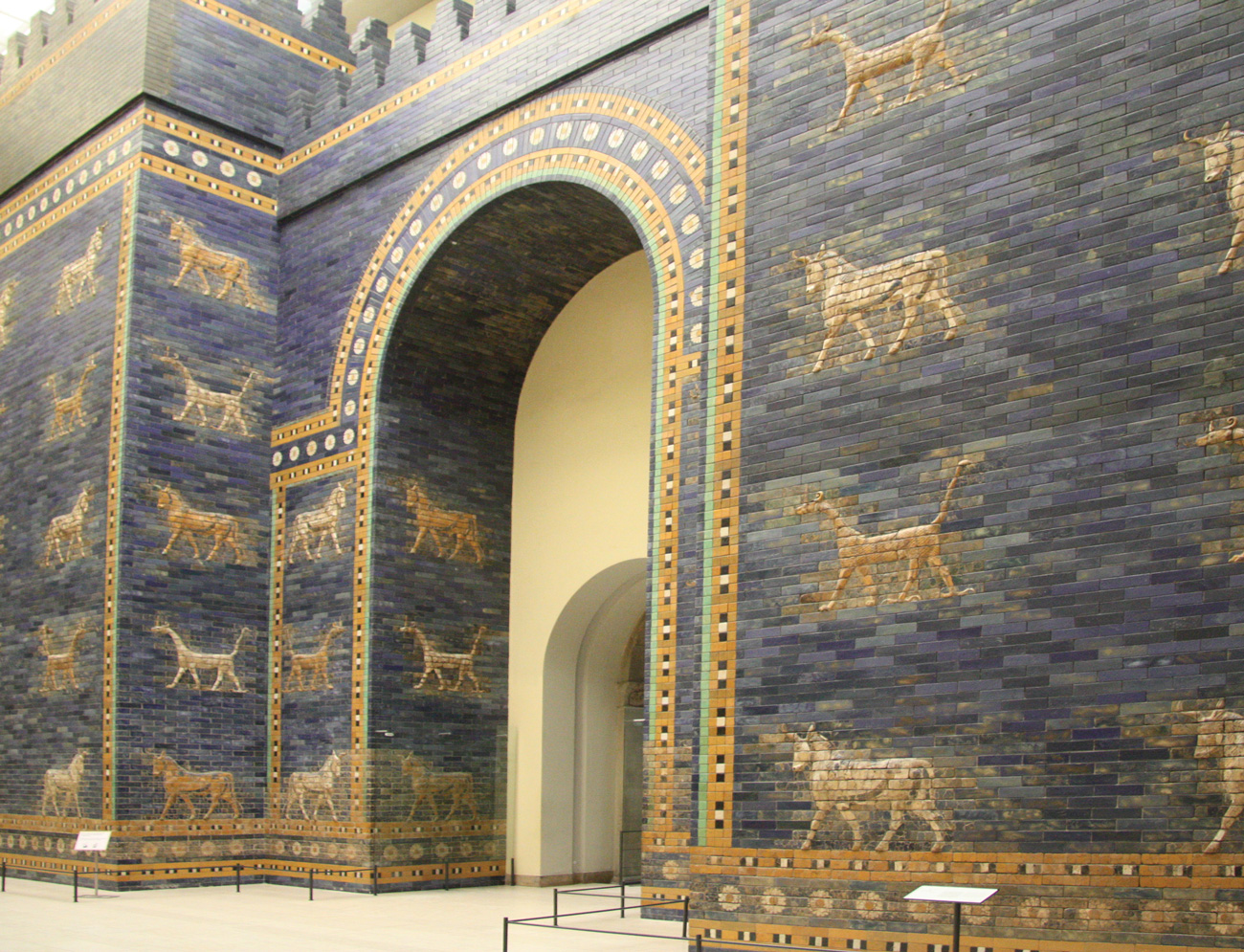
[ Copyright Baker Photo Archive. Courtesy of the Pergamon Museum, Berlin. ]
Clearly Isaiah was well acquainted with the city of Jerusalem, the temple (1:1115), the ways of the rich, and the suffering of the poor. Because of his love for Jerusalem, he never delights in the messages of doom to the city and her inhabitants. He pictures the city as a shelter in a vineyard (1:8), and he gratefully speaks about Gods mercy and desire to call a remnant who will return to Jerusalem after the exile and share in the joy God has prepared for the city and her population:

